Browse Resources by Year
Developing new and improved technologies is essential for the continued evolution of all aspects of space infrastructure. Advancements in technology can provide new capabilities that did not previously exist, and improve the cost, reliability, performance, and other essential attributes of existing systems, be they launch vehicles, spacecraft, or ground systems. A sampling of some emerging technologies under active development demonstrates the range of possibilities for our future in space.
Read MoreThe United States currently operates the most capable SSA system, the Space Surveillance Network (SSN). The SSN is composed of stations based around the globe that use a combination of radar and optical information to track objects in orbit. The system has impressive abilities; it is able to detect objects the size of a basketball at an altitude of ## kilometers (## miles), and smaller objects closer to Earth.
Read MoreGround stations serve as the links between Earth and space, tying together terrestrial and space infrastructure. They track satellites and spacecraft, as well as communicate with and control satellites, probes, crewed space vessels, and space stations.
Read MoreThis is a description of the Space Foundation methodology for classifying different satellite orbits with Earth at their focus.
Read MoreDefinitions of the various intelligence disciplines for an understanding of how they may apply to satellite collection operations.
Read MoreAs new operators and regional actors emerge, the mature players change their positioning in response. As governments map out a long-term, sustainable approach to exploration beyond the orbit of Earth, near-term programmatic and policy environments shift. As space investments generate returns, local and regional governments respond in order to better capture economic benefits. Understanding these dynamics yields an important perspective on opportunities and challenges.
Read MoreThese reports are available for download with particular subscriptions. The information contained within the files is also accessible on The Space Report Online, with accessible and optional data downloads.
Read MoreThe European Organisation for the Exploitation of Meteorological Satellites (EUMETSAT) had a total budget of €337.6 million (US$462.1 million) for 2014. The largest amount of funding was directed to the Meteosat Third Generation (MTG) program with €136.4 million (US$186.7 million), followed by the EUMETSAT Polar System (EPS) program worth €78.0 million (US$106.8 million)
Read MoreIran made another tentative foray into the global launch family during 2015. The country’s attempt . . .
Read MoreChina’s most recent human mission to space was in June 2013, when three taikonauts docked a capsule with the Tiangong-1 space station. Since then, China has announced plans to launch a second space station, Tiangong-2, to replace Tiangong-1. The Chinese government continued assembling and testing Tiangong-2 in 2015, intending to launch it into orbit sometime in 2016. A subsequent crewed mission, Shenzhou-11, would be launched later in 2016. The crew will dock with the Tiangong-2 and may stay in the space station as long as a month.
Read More